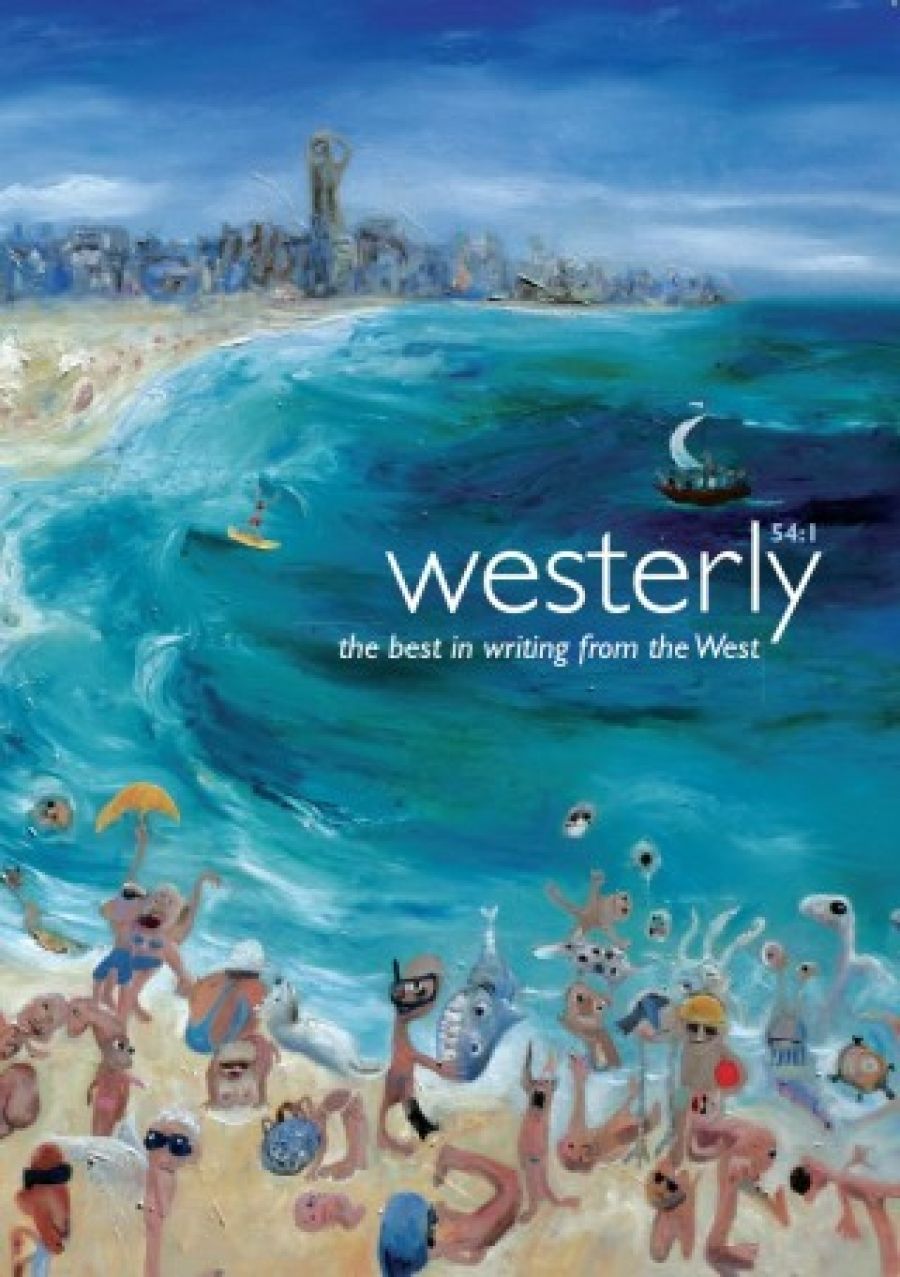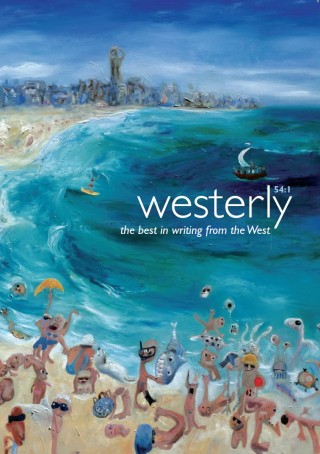
- Free Article: No
- Contents Category: Journal
- Review Article: Yes
- Article Title: Desert winds
- Online Only: No
- Custom Highlight Text:
One of the best things about the latest issue of Westerly is the cover, a detail from Helen Norton’s painting The shores of the excommunicated. Norton’s image is a wonderfully disquieting take on the modern Aussie beach. It inspires fresh ideas and imaginings, it unsettles, it punctures complacency, it provokes counter-reactions, but it also entertains – typifying what literary magazines should do.
- Book 1 Title: Westerly Vol. 54, No. 1
- Book 1 Biblio: Westerly Centre, $29.95 pb, 204 pp, 9780980437133
- Book 1 Cover Small (400 x 600):

- Book 1 Cover (800 x 1200):

Westerly is a conventional collection of essays, reviews, poetry and short stories. There is no overriding theme, and the distinctly Western Australian slant is non-provincial. The discursiveness is a plus, but there is also some unevenness – a common, perhaps congenital, problem for so-called ‘little magazines’. Here, the non-fiction is particularly strong, the poetry respectably solid and the fiction somewhat underwhelming.
In 1997, Elizabeth Durack, the octogenarian artist, writer and member of the noted pastoralist family, revealed that she was ‘Eddie Burrup’, previously understood to be an indigenous artist from Western Australia. Westerly includes three distinctive responses to Durack’s deception (disappointingly, the two Burrup–Durack paintings included are poor reproductions). Durack’s daughter, Perpetua Durack Clancy, offers mixed messages in defending her mother: the creation of Burrup was both ‘an ingenious work of art – one that combines paint, pen and performance’ and a recognition that Durack could not have hung her new ‘Aboriginal’ works under her own name. Louise Morrison then begins to prod the controversy, posing questions that she does not have the space to reflect on in depth. Was Durack a hoaxer, a cultural thief, an authenticity-seeker? Or, given that Burrup’s art was included in indigenous-only exhibitions and entered in indigenous-only awards, was she a plain fraudster? Morrison’s tentative conclusions are broadly sympathetic. She argues that the ‘slippage between black and white in Durack’s life and her art makes the Burrup works rare and rich reflections of our culture’.
Morrison points out that artists often adopt alter egos. But if the Burrup persona was part of Durack’s artistic expression, it seems odd that she did not immediately disclose the full extent of her achievement. In his all-too-brief counter to Morrison, Ted Snell argues that Durack’s action ‘undermines her credibility as an empathetic advocate of Aboriginal culture and reveals the emotional and intellectual turmoil of an artist’s musings at the end of a long career’.
Other essays ponder aspects of the history of writing and publishing in Australia and/or Western Australia. Susan Sheridan offers a penetrating interpretation of Dorothy Hewett’s transition from a communist writer ‘to a poet and dramatist recognised (though not always self-identified) as a feminist’. Per Henningsgaard recounts Fremantle Arts Centre Press’s formative years. By recalling its early hits (including début books of short stories by Elizabeth Jolley and Nicholas Hasluck) and misses (the press’s first novel, Antonio Casella’s satire Southfalia, 1980), Henningsgaard highlights the enduring legacy of independent publishers. Charles McLaughlin delves even further back into Western Australia’s literary history by disclosing fascinating research into the goldfields poets of the late nineteenth and early twentieth century.
More contemporary matters are covered by three review essays, which comment upon fiction, poetry and non-fiction works received by Westerly in 2008–09. Julian Croft ponders a perceived conundrum: while ‘Australian poetry is enjoying a golden age’, as Croft quotes Geoffrey Lehmann, this success seems insular. Susan Midalia extols those works of fiction ‘which remind us that there are many different ways of seeing and being in the world’. Her discussion is wide-ranging, thoughtful and uncontroversial; her consistently effusive praise dulls any critical edge. In contrast, Tony Simoes da Silva simultaneously compliments and unravels several noteworthy books of non-fiction. An example: Kim E. Beazley’s memoir, Father of the House (2008) is ‘lead-footed in its obsessive concern with the act of remembering as an academic exercise’. Yet da Silva half applauds Beazley Sr’s methodical yet energetic prose. More significantly, he notes the book’s importance as an historical document, not least as an inadvertent chronicle of ‘a time of overt, even naturalised sexism and unreconstructed patriarchal power’. But while da Silva’s essay is layered and insightful, his thin list of works received is utterly unrepresentative (memo to non-fiction publishers: send books to Westerly).
The twenty-six poets represented in Westerly offer enlivening interludes to the weightiness of the essays. Fiona Wright’s ‘Ulladulla’ is grittily evocative; Cameron Fuller’s ‘Morphecology’ has a dense resonance; and Roland Leach’s ‘For My Mother’ is a homage to resilience. While there is nothing especially outstanding among the rest, neither are there any duds. However, the five short stories (in contrast to twelve essays) are unremarkable and, in some cases, underformed. The best of them is Stephanie Dickinson’s ‘Dalloway & Hannah’s Womb’, a sardonic tale of surrogacy marred only by occasionally jarring dialogue and a rushed ending.
But the non-fiction stands out, whether it is nuanced bookchat or research findings, the Eddie Burrup controversy or fascinating asides, such as the image, from Charles McLaughlin’s essay on goldfields poets, of children appropriating pages from an abandoned trunk of poetry manuscripts ‘in a game that involved tossing them into the air to be whipped away by the desert winds’.


Comments powered by CComment